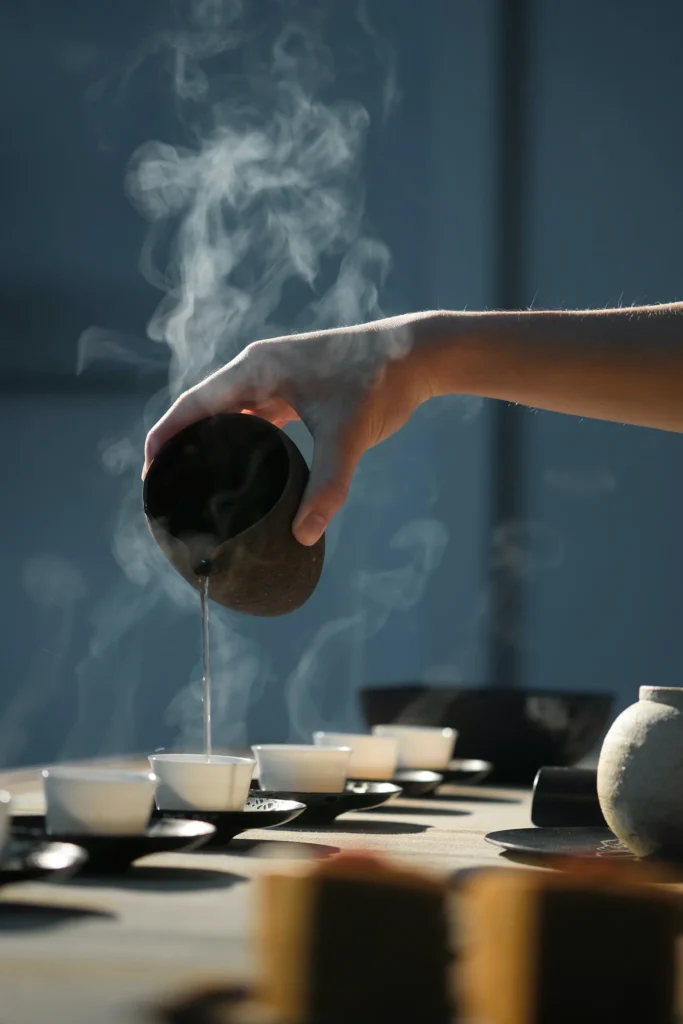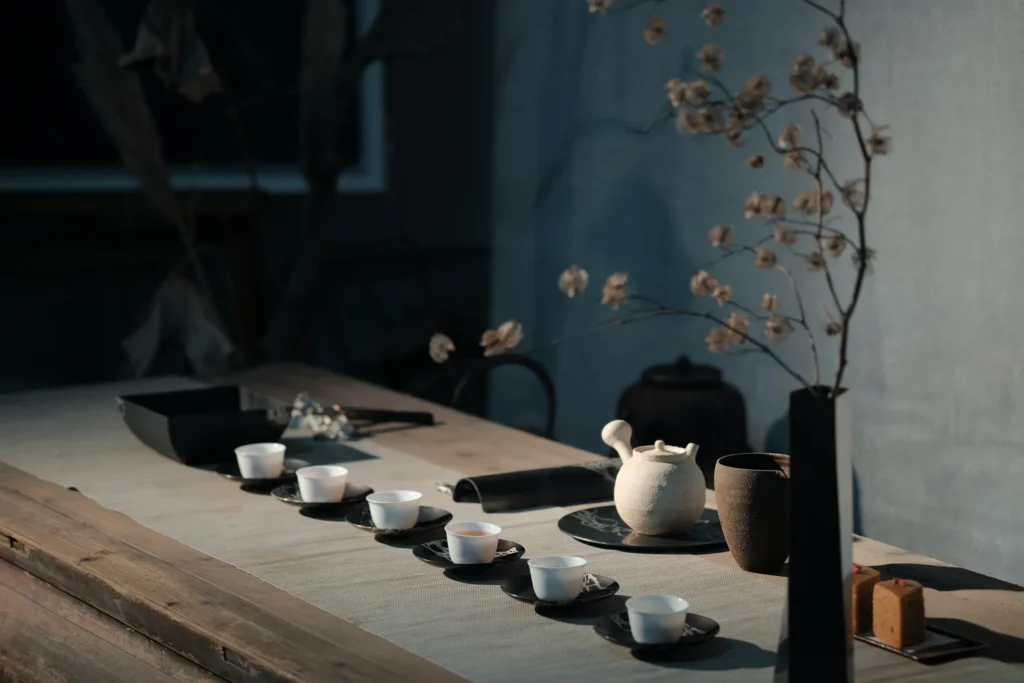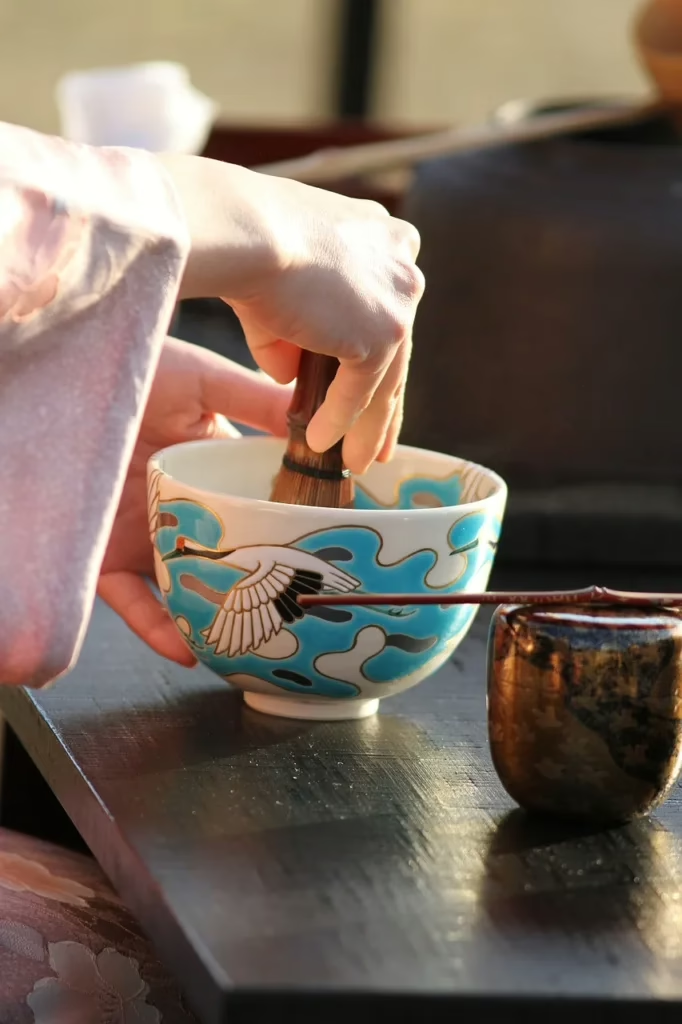The Japanese Tea Ceremony: Art, Ritual, and Mindfulness
Step into a world where every detail is intentional and every gesture is an invitation to slow down. The Japanese tea ceremony—chanoyu or sadō—is more than a social event: it is a living art form, a meditative practice, and an expression of Japanese hospitality. Every tea gathering is a unique performance, where the preparation, serving, and drinking of matcha becomes a pathway to inner peace, social harmony, and a deeper appreciation for the present moment.
While Japanese tea itself—matcha, sencha, genmaicha, hojicha, and more—has a rich story and remarkable health benefits (discover more in our Japanese Tea: Your Key to a Long and Healthy Life), the tea ceremony is its highest expression. It brings together history, design, nature, etiquette, and mindfulness into one serene ritual.
What Is the Japanese Tea Ceremony? (茶道, Sadō or Chanoyu)
The Japanese tea ceremony evolved over centuries, deeply influenced by Zen Buddhist principles and refined by generations of tea masters. Its purpose isn’t just to serve tea, but to offer an immersive experience—one uniting host and guest in harmony (wa), respect (kei), purity (sei), and tranquility (jaku). The smallest detail can have meaning: the choice of teabowl, a seasonal flower, the calligraphy scroll. The atmosphere is shaped by the season, the occasion, and even the personalities of those attending. Each ceremony is a once-in-a-lifetime event, never to be repeated in exactly the same way.
If you’re curious about everyday tea, steeping tips, or Japanese tea varieties, visit Japanese Tea: Your Key to a Long and Healthy Life.

The roots of the tea ceremony stretch back to the 9th century, when Buddhist monks first brought tea seeds and customs from China. Over time, Japanese tea practice evolved into a highly aesthetic ritual, closely tied to Zen meditation and samurai culture. Pioneers like Sen no Rikyu formalized the rules and the spirit, focusing on humility, natural beauty, and the value of each moment shared over tea.
The Essence of the Ceremony: Philosophy and Spirit
Three core principles define the heart of the tea ceremony:
- Wabi: The beauty of simplicity and imperfection—seen in rustic bowls and sparse décor. Wabi invites us to find contentment in what is unpolished or understated.
- Sabi: The quiet grace of age and natural patina, celebrated in weathered utensils and aged tatami mats. Sabi honors the passage of time and the serenity it brings.
- Ichigo Ichie: The belief that every meeting is a once-in-a-lifetime encounter, encouraging everyone to fully engage in the present. This mindset transforms the act of sharing tea into a rare, cherished moment.
The tea ceremony is a dance of mindful attention. Movements are slow and deliberate, reinforcing the value of presence. Even pouring water, folding a cloth, or placing a utensil is performed with awareness and intention. For guests, it is a chance to be present and grateful, setting aside daily worries and simply appreciating what unfolds.
The Setting: Architecture and Ambiance
Unlike casual tea drinking, the tea ceremony unfolds in a purpose-built space—often a small, detached teahouse (chashitsu) or a serene garden corner. The approach is an important ritual: guests walk a stone path through a mossy garden, pausing to wash hands at a stone basin (tsukubai) for symbolic purification. This journey helps guests shed worldly concerns and prepare for a peaceful experience.
Inside the tea room:
- Décor is minimal, usually featuring a single scroll (kakemono) with a Zen phrase or poem, and a simple flower arrangement (chabana).
- Lighting is subdued, often filtered through shoji screens or flickering candles.
- Tatami mats line the floor; guests are seated to reflect social harmony and hierarchy.
In some traditional tea houses, guests enter through a small, low door—a gesture that humbles everyone and symbolizes leaving the outside world behind. In winter, the room may be warmed by a sunken hearth, while in summer, fresh breezes and open doors connect the gathering to nature.

Explore more about Japanese aesthetics in our article on Traditional Japanese Architecture & Design.
Ritual Flow: Steps of a Traditional Tea Ceremony
The ceremony follows a centuries-old structure. Here’s what to expect:
- Arrival and Greeting: Guests are welcomed, often in silence or with a bow, establishing a respectful mood.
- Cleansing: Before entering, guests rinse hands and mouth, leaving behind distractions and entering a meditative state.
- Admiring the Tokonoma: Upon entering, guests appreciate the scroll and flowers, which set the gathering’s theme.
- Preparation of Utensils: The host carefully cleanses each utensil (bowl, whisk, scoop, caddy) in full view. Every gesture is deliberate and respectful.
- Serving Sweets: Seasonal Japanese sweets (wagashi) are presented, balancing the matcha’s bitterness. The choice of sweet often reflects the time of year or the occasion.
- Whisking the Matcha: The host scoops matcha, adds hot water, and whisks it into a frothy green tea. This moment is quiet, almost hypnotic, as the scent of matcha fills the air.
- Serving the Tea: The bowl is offered in turn, with a bow. Guests rotate the bowl before sipping—a sign of humility, so as not to drink from the most beautiful side.
- Appreciation: After drinking, guests admire the utensils, sometimes discussing their origin. Every object has a story, whether newly crafted or centuries old.
- Conclusion: The ceremony ends with bows, and guests return to the outside world, feeling grounded and connected.
To see a step-by-step visual, check out this video guide from The Urasenke Foundation.
Tools of the Ceremony: Tradition in Every Detail
Each tea ceremony uses special tools, chosen with care and often rich in meaning:
- Chawan (tea bowl): Handcrafted, unique, and often treasured. The style might change with the season—heavier in winter, lighter in summer.
- Chasen (bamboo whisk): Used to froth the matcha, crafted from a single piece of bamboo. The art of making a chasen is itself a cherished craft.
- Chashaku (bamboo scoop): For measuring powdered tea, shaped and signed by artisans.
- Natsume or Cha-ire (caddy): For storing matcha, with seasonal styles—lacquered wood or fine ceramics.
- Fukusa (silk cloth) and Chakin (linen cloth): For purifying utensils; each fold and movement is meaningful.
- Kensui, Kama, Hishaku: For handling and boiling water, often with a poetic name or history.
Learn more about Japanese crafts and tools in our feature: The Best Japanese Art Destinations.
Some tea masters collect rare utensils and pass them down for generations. Guests may be invited to hold and admire them, connecting with the lineage of the tea tradition.
Etiquette: Mindfulness in Every Action
Participation is about more than tea—it’s shared mindfulness. Key etiquette:
- Observe silence: Much of the ceremony is quiet, enhancing appreciation of every detail. Listen for subtle sounds—the whisk in the bowl, water boiling, a distant bell.
- Follow the host: Bowing, turning the bowl, and eating sweets are done in specific ways—mirror the host or experienced guests.
- Appreciate the details: Complimenting utensils or seasonal touches is encouraged. Thoughtful conversation is welcome at the right moments.
- Dress simply: Modest, subdued dress fits the spirit. Many visitors wear traditional kimono, but neat Western attire is also acceptable.
If you are new, don’t worry about making mistakes—your host will guide you gently. The most important thing is sincere appreciation.
Explore Japanese culture and etiquette further in Unique Museums in Tokyo.
Experiencing the Tea Ceremony in Japan
If you travel to Japan, attending a tea ceremony is unforgettable. While tradition began in temples and samurai households, today you can join ceremonies in cities and countryside.
Top places to try a tea ceremony:
- Kyoto: The heart of tea culture, with authentic tea houses like Camellia Flower Teahouse and En Tea Ceremony Experience. Some venues offer English guidance for beginners.
- Tokyo: Happo-en, Hotel Chinzanso, and Hamarikyu Gardens offer public ceremonies in beautiful gardens.
- Kanazawa: Known for samurai heritage and tea gardens—Gyokusen-en is a top choice, especially in spring when the garden blooms.
Some temples and cultural centers offer “beginner’s ceremonies” for learning the basics and etiquette. Booking in advance is recommended for the best experience.
Want to deepen your understanding? Check out this travel guide to Japan’s Most Beautiful Temples & Shrines.
Tips for First-Timers
- Arrive early and observe the garden or entrance before you go in—it sets the mood for the ceremony.
- Watch your host and other guests for cues on when to bow, accept the tea, or eat the sweet.
- Take a moment to feel the texture and shape of the bowl in your hands before you drink. This tactile connection is part of the art.
The Tea Ceremony in Modern Japan
While tradition remains, the ceremony evolves:
- Modern utensils or non-traditional sweets may appear. Some ceremonies are now held in cafes, hotels, or outdoor settings.
- Female tea masters lead schools—a recent shift, as the art of tea opens to all.
- Many young Japanese embrace the ceremony to disconnect from busy life and reconnect with self and nature.
Many families keep simple tea sets for informal gatherings, blending daily life with the spirit of ichigo ichie. You may even encounter “tea and art” collaborations, pop-up experiences, or creative twists on the ritual in Japan’s cultural capitals.
For trends in modern Japanese culture, see Current Trends in Japan.
Beyond the Ceremony: Deepening Your Tea Journey
The tea ceremony is just one part of Japan’s broader tea culture. If you’re inspired to explore daily tea habits or different types, revisit Japanese Tea: Your Key to a Long and Healthy Life.
Incorporate small rituals—like mindful sips or preparing matcha with intention—into your own daily routine. Even the act of boiling water with awareness can bring a little more harmony to your day. Try different types of Japanese tea, visit local tea shops, or practice preparing matcha at home with friends.
For more insight on Japan’s love for tradition and innovation, read Japan: The Blend of Old and New.
Final Thoughts
The Japanese tea ceremony invites us to slow down, observe, and connect—with others, with tradition, and with the fleeting beauty of the present. Even the simplest acts become art when approached with mindfulness and respect. No matter where you are in the world, the spirit of ichigo ichie—this one, unique moment—can enrich your life.
Ready to experience the tea ceremony in Japan? Start planning your journey, and let the art of tea open your eyes to the deeper rhythms of Japanese life.
If you need this formatted for WordPress, want a downloadable PDF, or require unique photo curation, just let me know!
